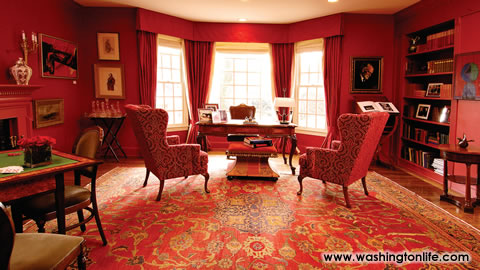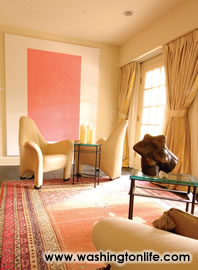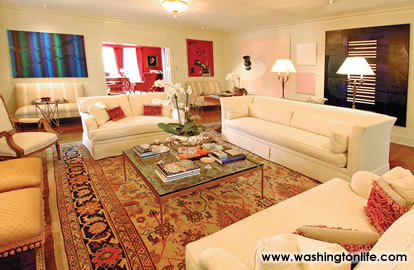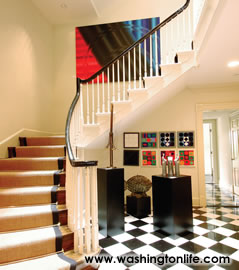Hungarian Rhapsody Reinventing the Art of Diplomacy at the Hungarian Embassy Residence
with Aniko Gaal Schott
|
||||||||||||||||||||
 |
By 2003, it had become abundantly clear that the old concrete compound which housed the Hungarian ambassador’s residence did not reflect today’s free and democratic Hungary. Nor was it ever likely to be an appropriate venue in which Ambassador András Simonyi and his wife Náda could celebrate and showcase the new role of Hungary on the world scene. Consequently, in late 2003, at Mrs. Simonyi’s behest, the Hungarian government purchased the former house of Senator John Edwards at 2215 30th Street, N.W. for three million dollars.
 |
To decorate the 20,000 square-foot residence, the ambassador and his wife found the obvious choice in Aniko Gaal Schott and her assistant Elizabeth Balish.As a Hungarian-born interior decorator who has completed a number of projects for embassies both here and abroad, Schott possessed the perfect combination of knowledge, skill, and experience needed to capture the Magyar character and culture. She knew her main challenge would be to stay within budget while creating an environment pleasing, both to Ambassador and Mrs. Simonyi and to the Hungarian Foreign Office. “An embassy residence must reflect the integrity of the country as well as the personalities of the residents. In this case, the ambassador and his wife wanted simplicity and comfort as well as a clear way in which to feature Hungarian contemporary art,” Schott says.
As the Ambassador explained the project, “We are in the process of reinventing diplomacy.” “Diplomacy,” he says, “is about communication.” Although Simonyi speaks six languages, he feels it is through music and the arts in general that one reaches the widest audience. As an accomplished Blues guitarist trapped behind the Iron Curtain in his youth, he connected to the West through music and came to recognize the power of the arts as a force for change. Since then, the economist who studied at Karl Marx University and holds a Ph.D. in Political Science has performed both politically and musically on the world stage.
To achieve their goal of communicating through the arts, the Ambassador and his wife chose works by eight painters and two sculptors from among Hungary’s best known modern artists. While each had major works on display in museums throughout the world, the Simonyis did not know which pieces the masters might loanthem. Among the more intriguing are those by László Feher, which, as Náda Simonyi explains, demonstrate “the delicate line between existence and non-existence,” and by extension, the fragility of human beings or at least of the lone individual. In each case the human subject is shown as an outline, almost a negative against the more solid inert objects. Whether it’s the male figure depicted on the canvas entitled “On the Stones,” or the vacant eyed child touching a table, it is a clear reminder that one’s external setting or circumstances can influence, dominate or even overwhelm the individual. Schott’s choice of cream colored walls provides the perfect backdrop to highlight the artwork. Her one concession to brightly painted walls is in the study where the room has been finished in terracotta red.
Although her clients were initially opposed to red, perhaps fearful that it would be too reminiscent of Communism, the den’s atmosphere is in no way repressive. The darker shade adds to a feeling of warmth and comfort and is, as Schott says, “at once charming and cozy, yet rigorous enough to be functional.” Moreover, the walls perfectly match the vibrant Zsolnay porcelain vases displayed on the mantelpiece. Further enhancing the rich feel of the room is the intricately detailed trapezoid ottoman Schott designed. The ottoman also serves as a reminder of Hungary’s long turbulent struggle with the Turks.
 |
 |
If the Ambassador wasn’t thrilled by the thought of red walls in his den, he was enthusiastic about the portrait titled “Large Pink Face” exhibited in the sunroom one floor below. Of the residence’s many artworks, the Ambassador says this is his “absolute favorite.” The portrait painted by Tamás Soós with barely visible brush strokes in muted shades of red, appears to be of a wizened old woman, an artistic reference perhaps to the fading face of the past. Strategically situated in front of the portrait are two cream colored leather chairs designed by Attila Dienes, the Transylvanian sculptor who is also responsible for a number of decorative objects in the adjacent reception room.One of the more interesting and unusual of the sculptures there is a bronze bust of a man with a detachable head. Náda admits that periodically she will turn his head in a new direction to give him a fresh perspective or a different view, an action consistent with all that she and her husband have sought to communicate about the changing reality of their homeland and its role in the world.
One of the artists most widely represented is István Nádler, whose huge abstracts fill the dining room walls. The oversized canvasses are so large they had to be hung horizontally despite the fact that the images were painted as vertical images. Here again, a change of perspective and a new direction seem to be the appropriately implied message. Also in keeping with the theme of movement and change is the prominently positioned kinetic pendulum in the entrance hall. Created by the sculptor István Harasztÿ, it is titled “Fluttering.” The artist’s major works are commonly considered to be caricatures of the political, social and bureaucratic views of Socialism. Others of his sculptures are said to depict Soviet oppression. Consequently, the inclusion of any of his works in this home would seem to connote a condemnation of Communism and it’s limitations on freedom of expression or movement.
 |
 |
The foyer |
Of the many rooms in which artwork are exhibited, the drawing room is favored by both Náda Simonyi and Schott. It is by far the most elegant of the reception rooms and one of the few public spaces where objects owned by the Ambassador and his wife are displayed. Here for example, the couple’s highly polished silver and hand-painted Herend porcelain are as eye-catching as any of the modern art. The most expensive piece of furniture in the residence is also in the drawing room: an antique Hungarian walnut and teak tabernacle-style chest of drawers. The beautifully designed cabinet, dating from the early 1800s, pays homage to the reign of Empress Maria Teresa. The Ambassador was especially delighted with the chest because its decorative motif very much resembles the symbol of NATO, where he served as Hungary’s ambassador for nine years prior to being posted the United States.
While works by the ten featured contemporary artists are the central attraction in any given room, a combination of Hungarian and other antiques coexists with modern aspects of the decor in each of the public areas. Thus, in the formal dining room where the Nádlers dominate, guests sit on Chippendale style chairs around an 18th century English mahogany table beneath an 18th century French mirror. Meanwhile, in the first floor reception room, two 18th century French Boullé chests inlaid with ivory and topped with granite occupy space across from a Secessionist era Hungarian sofa and a József Bullás abstract work.
In creating a showcase of contemporary art, the Simonyis, Schott and Balish have succeeded in combining their taste and talent to re-do an interesting and inviting residence worthy of Hungary’s freedom and ascension to the world stage. They have fused the old with the new to put a contemporary face on the past while highlighting the quality of that land’s rich history and cultural heritage.
